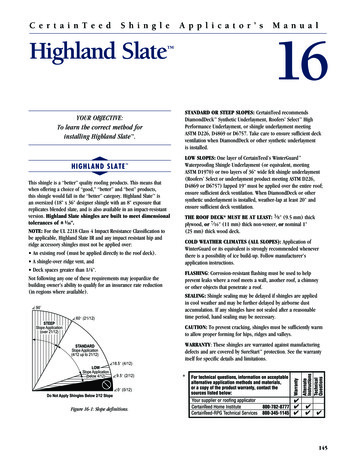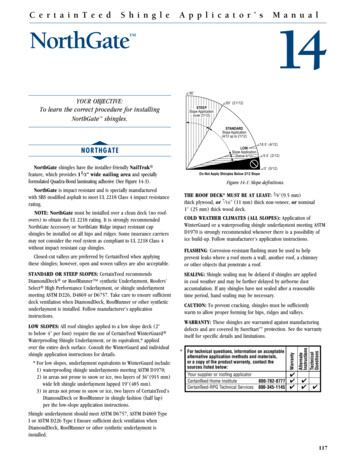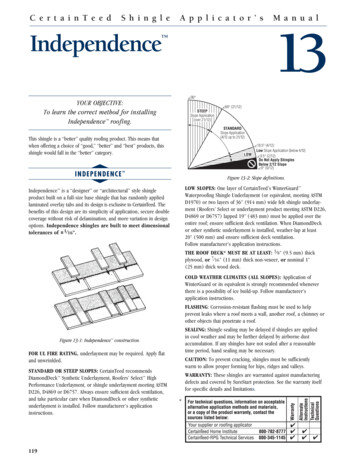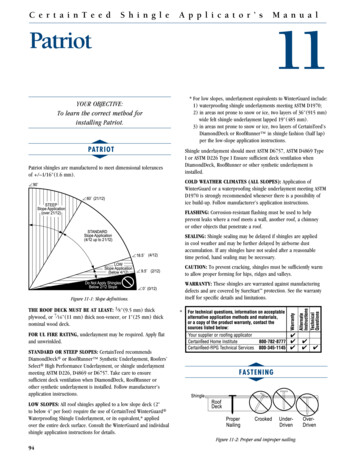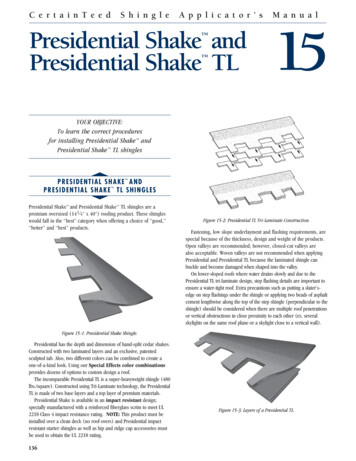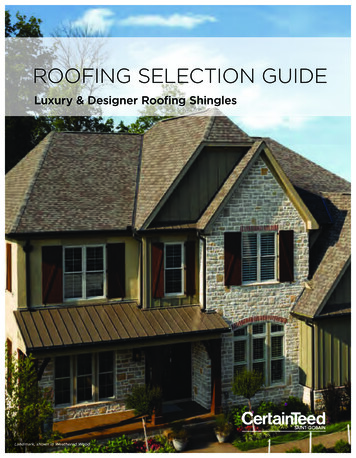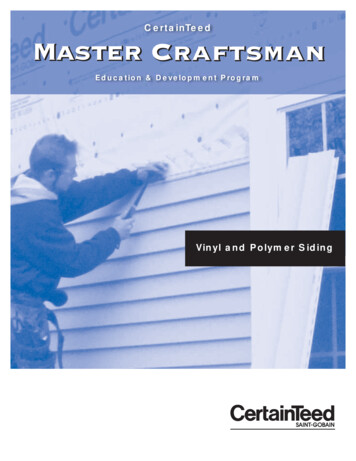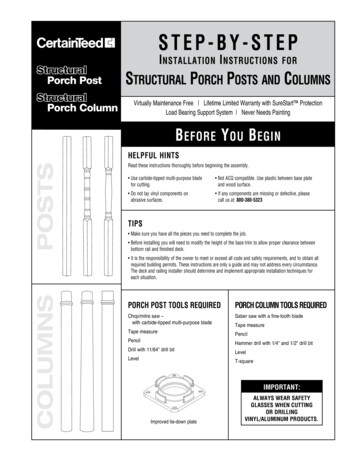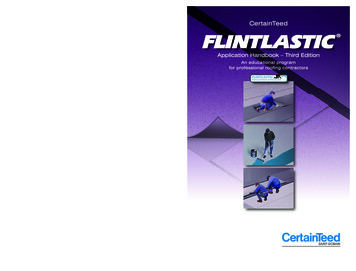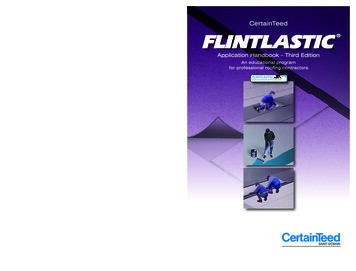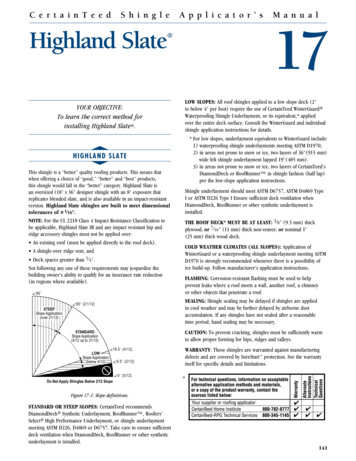
Transcription
MC Ae Sr Tt Ea RiP Pg Ll Ie C AA TpOpRl’ iS c Mn STHeI eN dG L SE h Ai na tA oN rU ’AsL M a n u a lTHighlandE A R I N G SlateOFF OLDROOFING? YOUR OBJECTIVE:To learn the correct method forinstalling Highland Slate . LOW SLOPES: All roof shingles applied to a low slope deck (2"to below 4" per foot) require the use of CertainTeed WinterGuard Waterproofing Shingle Underlayment, or its equivalent,* appliedover the entire deck surface. Consult the WinterGuard and individualshingle application instructions for details.* For low slopes, underlayment equivalents to WinterGuard include:1) waterproofing shingle underlayments meeting ASTM D1970;2) in areas not prone to snow or ice, two layers of 36"(915 mm)wide felt shingle underlayment lapped 19"(485 mm).3) i n areas not prone to snow or ice, two layers of CertainTeed’sDiamondDeck or RoofRunner in shingle fashion (half lap)per the low-slope application instructions.sH IGH LAND SLAT EtThis shingle is a “better” quality roofing products. This means thatwhen offering a choice of “good,” “better” and “best” products,this shingle would fall in the “better” category. Highland Slate isan oversized (18" x 36" designer shingle with an 8" exposure thatreplicates blended slate, and is also available in an impact-resistantversion. Highland Slate shingles are built to meet dimensionaltolerances of 1 16".NOTE: For the UL 2218 Class 4 Impact Resistance Classification tobe applicable, Highland Slate IR and any impact resistant hip andridge accessory shingles must not be applied over: An existing roof (must be applied directly to the roof deck). A shingle-over ridge vent, andShingle underlayment should meet ASTM D6757, ASTM D4869 TypeI or ASTM D226 Type I Ensure sufficient deck ventilation whenDiamondDeck, RoofRunner or other synthetic underlayment isinstalled.THE ROOF DECK* MUST BE AT LEAST: 3 8 " (9.5 mm) thickplywood, or 7 16 " (11 mm) thick non-veneer, or nominal 1"(25 mm) thick wood deck.COLD WEATHER CLIMATES (ALL SLOPES): Application ofWinterGuard or a waterproofing shingle underlayment meeting ASTMD1970 is strongly recommended whenever there is a possibility ofice build-up. Follow manufacturer’s application instructions. Deck spaces greater than 1 4 ".Not following any one of these requirements may jeopardize thebuilding owner’s ability to qualify for an insurance rate reduction(in regions where available).F LASHING: Corrosion-resistant flashing must be used to helpprevent leaks where a roof meets a wall, another roof, a chimneyor other objects that penetrate a roof.90 STEEPSlope Application(over 21/12)SEALING: Shingle sealing may be delayed if shingles are appliedin cool weather and may be further delayed by airborne dustaccumulation. If any shingles have not sealed after a reasonabletime period, hand sealing may be necessary.60 (21/12)STANDARDSlope Application(4/12 up to 21/12)LOWSlope Application(below 4/12)173CAUTION: To prevent cracking, shingles must be sufficiently warmto allow proper forming for hips, ridges and valleys.18.5 (4/12)Do Not Apply Shingles Below 2/12 SlopeWARRANTY: These shingles are warranted against manufacturingdefects and are covered by SureStart protection. See the warrantyitself for specific details and limitations.9.5 (2/12)0 (0/12)*Figure 17-1: Slope definitions.STANDARD OR STEEP SLOPES: CertainTeed recommendsDiamondDeck Synthetic Underlayment, RoofRunner , Roofers’Select High Performance Underlayment, or shingle underlaymentmeeting ASTM D226, D4869 or D6757. Take care to ensure sufficientdeck ventilation when DiamondDeck, RoofRunner or other syntheticunderlayment is installed. 141
C E R T A I N T E E DS H I N G L EA P P L I C A T O R’ SM A N U A LsFAST ENINGC LEAN DEC K APPLIC ATIO N METH ODTEARING OFF OLDROOFING?ttPREPARING THE enOverDrivenFigure 17-2: Proper and improper nailing.uFor decks(19 mm) thick or thicker, nails must go at least3 4 " (19 mm) into the deck. On thinner decks, nails must go at least1 8 " (3.2 mm) through the deck.Nails must be 11- or 12-gauge roofing nails, corrosion-resistant,with at least 3 8 " (9.5 mm) heads, and at least 11 4 " (32 mm) long.LOW AND STANDARD SLOPE:9"(230 mm)9"(230 mm)1"(25 mm)9"(230 mm)1"(25 mm)9-3/8"(240 mm)Miami-Dade requiresSIX nails (two nailsinstalled over centercutout as shown).1" (25 mm)Figure 17-3: Use FIVE nails for every Highland Slate shingle.For Miami-Dade, SIX nails are required (see inset).ALIGNMENT: Snap horizontal and vertical chalklines to assureshingles will be correctly aligned. Expose all shingles 8".ANT!PORTMISTARTER COURSE:1. Use CertainTeed’s High-Performance Starter Shingles or removethe lower 8" tab portions from Highland Slate shingles. This is arequirement in order to be eligible for the 110 mph windwarranty. Do not rotate or “flip” full shingle. Sealant stripes must beat lower-most edge.2. Cut 41 2 " off the LEFT end of the first starter shingle only.3. Apply the 311 2 " remaining piece to the lower left corner of the roof.Make sure there is 1 2 " overhanging the rakes and eaves if dripedge is being used. If you are not using drip edge, make theoverhang 3 4 ". Install nails approximately 3" up from eave, assuringthey go into solid wood.4. Use full 36" long by 10" wide starter shingles for the rest of thecourse.HIGHLAND SLATEStarter ShingleUse FIVE nails and EIGHT spots of asphalt roofing cement* for eachfull Highland Slate shingle. For Miami-Dade, SIX nails are required.Apply 1" diameter spots of asphalt roofing cement under each tabcorner. Asphalt roofing cement meeting ASTM D4586 Type II is suggested.9"(230 mm)9"(230 mm)9"(230 mm)1"(25 mm)9"(230 mm)1"(25 mm)9-3/8"(240 mm)1" (25 mm)Roofing CementFigure 17-3A: Use FIVE nails and eight spots of asphalt roofing cement under each tab corner.*CAUTION: Excessive use of roofing cement can cause shinglesto blister. 14241 2 " Single Column Vertical Racking M ethod.36" (920 mm)Full LengthSTEEP SLOPE:Miami-Dade requiresSIX nails (two nailsinstalled over centercutout as shown).Apply underlayment as required. CertainTeed suggests that alayer of shingle underlayment be applied. For UL fire rating,underlayment is generally required. Apply flat and unwrinkled.INSTALL ON NEW ROOFS AND TEAR-OFFS USING THEFOLLOWING METHOD:3 4 "9"(230 mm)3sChapter 1710"(254 mm)R e m o v e t h i s p o r t i o nFigure 17-4: Make starter shingles by removing the lower 8" portion.1ST COURSE: (Figure 17-6). Apply a full Highland Slate shingleat the lower left corner of the roof, flush with the starter course leftcorner. Fasten with 5 nails.2ND COURSE: (Figure 17-6). Cut 41 2 " off the left end of a fullshingle and apply remaining 311 2 " piece over left edge of 1stcourse. Fasten with 5 nails and ensure 8" exposure.SUCCEEDING COURSES: Begin application of the 3rd course with afull shingle. Fasten with 4 nails, leaving the right end unfasteneduntil later. (Figure 17-6). Begin the 4th course using a shingle with41 2 " cut off its left end. Fasten with 5 nails. To begin the applicationof subsequent courses, alternate full shingles [36"] and cut shingles[311 2 "] up the rake edge, fastening as described above.REMAINING COLUMNS AND COURSE COMPLETION:Apply a full shingle against the right edge of each shingle in previouscolumn. When applying a shingle against a covered shingle, carefullylift the right edge of the shingle above and slip the new shingle underit. Fasten as usual with 5 fasteners; then, fasten the loose right edgeof the shingle above.C E R T A I N T E E D S H I N G L E A P P L I C A T O R’ S M A N U A L
M A S T E RS H I N G L EA P P L I C A T O R’ SM A N U A L3R id g eTEARING OFF OLDROOFING?eckRoof D)0 mm2'' (5 e LapSidlMetapDri eEdgal StmenforDripetalMkeRalMetaDrip geEdfingRoo mentCeeEdgle 31hinger SStartFirstmm)(8001/2''oveRemes)mm(13 used.1/2''out edge isbapsave o drind e ) if nke a mme ra (19er th ut 3/4''voosbingle or ae sh sed,nd th is uExte rip edgediftmm)2'' (50e LapSidm)00 m4'' (1 LapEndkeRarlayUndeforte rtaretertaral StionOptionOpRakaymenUnderlEav''4 1/2 m)m(115gleshinuntil vious .redstenot fa t to the p n applienoDbeecenadja rse hascoueours3rd C2eours1st CFigure 17-5: Standard slope underlayment and starter drip edge details.eourster CStarrseound C8''mm)(203Figure 17-6: Applying the first three courses on a standard slope.Figure 17-7: Installation schematic.Trim flush to roof deck openingRidgeVentnt36'' (9Waterp 14 mm)roofing ShingaymeUnderlle UnUnde4 1/2'' (11*Adequate attic ventilation creates a coolerattic in the summer and a drier attic in the winter.It also helps prevent premature failure ofshingles, roof deck movement/deterioration,and formation of ice dams. Shingle damage orfailure resulting from inadequate ventilation isnot covered by CertainTeed's Limited ShingleWarranty. Contractors only, for furtherinformation about attic ventilation, please consultthe "CertainTeed Shingle Applicators Manual"(call 1-800-404-9880 for a copy), and/or"The Principles of Attic Ventilation" brochure(call 1-800-AIRVENT for a copy).mentrlayment5 mmAAir FlowThrough SoffitderlayBColumn 2tmenerlay ardUnd interGu mm)W0laps 2" (5)Line valley by centering 36" (914 mm)wide CertainTeed WinterGuardWaterproofing ShingleUnderlayment or equivalent*directly to deckLay shingles onsmaller roof area,across valley and onto theadjoining roof area at least12" (305 mm)Column 1Do not nail within6'' (152 mm) of valleycenterlineEmbed each shingle in a 2" (50 mm)wide strip of asphalt roofing cement*Cut 2'' (50mm) diagonally offupper corner of trimmed shingleLCCut shingles 2''(50mm) back fromvalley centerlineFigure 17-8: Highlight of closed-cut valley detail.C E R T A I N T E E D S H I N G L E A P P L I C A T O R’ S M A N U A LChapter 17 143
C E R T A I N T E E DS H I N G L EA P P L I C A T O R’ STEARING OFF OLDROOFING?M A N U A L12" )m(305 moverApply r shinglestarteCapping Hip & Ridge:Use CertainTeed’s Cedar Crestor Shangle Ridge hip and ridge shingles of a like color.(Cedar Crest shown)4"m)(102 mhinglersStarte12"m)(305 m8"m)(203 mureoexp s1" (251" (25mm)mm)2" mm)(503"8 5/8 m)m(219Alternate Method: Make cap shingles cut fromHighland Slate shingles.Figure 17-11: Apply a full cap shingle over the starter shingle.Figure 17-9: Installation of caps along hips and ridges.12" )m(305 m8"m)(203 mureExpossCE D A R CREST M EDIU M -P ROFILEH I P A ND R IDGE ACCESSORY SH INGLES1" (25mm)"8 5/8mm)(219tCrest Use Cedaraccessory shingles to cover hips and ridges.Carefully separate the three-piece units prior to application, byfirst folding along the pre-cut lines and then detatching the pieces(see Figure 17-10). No cutting is necessary. There are 30 individualshingles (10 three-piece units) in each bundle. One bundle willcover 20 linear feet. Each 12" x 12" shingle has a shadowline that isa design feature which is visible when applied properly. To preventshingle damage during application, they must be sufficiently warm toallow proper forming.Three-piece unitShadowline123Figure 17-10: Separate to make 3 cap shingles.FASTENINGIMPORTANT: Use TWO nails to fasten each shingle. Fasteners mustbe minimum 13 4 " (45 mm) long. For the starter shingle, placefastener 1" in from each side edge and about 2" up from the startershingle’s exposed butt edge, making sure fastener goes 3 4 " into thedeck or all the way through the deck. (see Figure 17-11). For eachfull Cedar Crest shingle, place fasteners 85 8 " up from its exposedbutt edge and 1" in from each side edge (see Figure 17-12). 144Chapter 17Figure 17-12: Install cap shingles at an 8" exposureand fasten with one nail on each side as shown.IMPORTANT: High Wind Instructions. In order to achieve theASTM D3161 Class “F” Wind Resistance Classification each “hip andridge” shingle must be both 1) fastened with nails as shown and 2)hand-sealed with two 1 4 " wide beads of either BASF “Sonolastic NP1 Adhesive” or Henkel “PL Polyurethane Roof & Flashing Cement” appliedfrom the middle of the shingle’s raised overlay on the top piece andextending approximately 4" along the sides of the headlap along aline 3 4 "-1" in from each side edge of the shingle’s headlap as shown.Immediately align and apply the next overlying shingle, gentlypressing tab sides into adhesive.Hand-sealing adhesiveOnly one side of the doublethickness tab is laminated4"together; to secure the other side, 1/4"after folding the shingle over theridge and nailing into position,3/4"a 1" diameter spot of either NP1or PL adhesive must be applied1"between the shingle layers asDab of asphaltcement betweenshown. Immediately align and1"shingle layersapply the next overlying shingle,Figure 17-13: Hand seal caps.gently pressing tab sides intoadhesive.C E R T A I N T E E D S H I N G L E A P P L I C A T O R’ S M A N U A L
M A S T E RS H I N G L EA P P L I C A T O R’ SM A N U A L3CEDAR CREST APPLICATION TEARING OFF OLDROOFING?Apply primary roofing up to hip or ridge on both sides of roof andtrim flush. Ensure that the Cedar Crest shingles will adequately coverthe top course of the shingles on both sides of the hip or ridge.Prepare a 4" “starter” shingle by cutting off the lower 8" color granule portion of one Cedar Crest shingle. Apply the 4" starter piece withraised overlay edge over the bottom corner of the hip or to eitherend of the ridge, overhanging the corner or end by approximately1 2 " and bending the starter shingle along its centerline to form intoplace (see Figure 17-11). Install a nail on each side about 2" upfrom the starter shingle’s exposed butt edge and 1" in from each sideedge of the shingle.Then apply a full 12" x 12" piece over the starter, bending theshingle along its centerline and forming it into place over the hipor ridge, flush with the bottom and side edges of the starter shingle.Fasten with two nails minimum 13 4 " long with one nail on each sideof shingle 85 8 " up from the butt edge and 1” in from each side edge(see Figure 17-12).Continue application of Cedar Crest shingles up the hip or alongthe ridge, forming each shingle over the hip or ridge, and fasten asshown in Fastening. Expose Cedar Crest shingles 8", covering allfasteners.To assist in proper alignment, snap a chalk line parallel to the hipor ridge applying along the line where the side edges of the CedarCrest shingles should be.Figure 17-14: Shangle Ridge .6. B end the cap along the centerline of its longer dimension so thatit forms into place over the hip or ridge.7. Fasten each cap with two fasteners (Figure 17-15). The fastenersmust be 13 4 " long, or longer, so they penetrate either 3 4 " intothe deck or completely through the deck, exposing at least 1 8 "of the tip of the nail. Expose 8" of the Accessory along the ridgeor hip line and cover all fasteners.18"1"8"Fasten theleft sideFIRSTsHIP S AND RIDGESRemove tapefrom the right sideand fastenSECONDExposureRIGHT8 5/ 8"LEFTtFigure 17-15: Installation of Shangle Ridge shingleson hips and ridges.Apply Shangle Ridge shingles to hips and ridges.1. Each shingle is a 12" by 18", color-coordinated, pre-assembled,double-layered product. Exposure is 8".2. Apply Grand Manor or Carriage House up to the hip or ridge fromboth sides and trim flush. Allow for adequate coverage by makingsure the last course of shingles will not be exposed more than 8”when the cap shingles are applied.3. To assist with proper alignment when ridge vents aren’t used, snapa chalk line parallel to the hip or ridge along the line where theside edges of the cap should be.8. I f shingle-over ridge vents are being installed (Figure 17-16),they must match the 12" width dimensions of the hip and ridgecaps. Be sure to follow the ridge vent manufacturer’s instructions.To attach the cap shingles to the shingle-over ridge vent, use hotdipped galvanized nails of sufficient length to penetrate 3 4 " into,or through, the deck.For capping hip and ridge, applyCertainTeed Shangle Ridge shinglesof a like color.4. If possible, try to start at the end of the ridge opposite to wherethe prevailing wind strikes the house. This will give the wind andrain less of a chance of getting underneath the cap. As for the hip,begin by installing the cap at the bottom and work your way up.Ridgegush toTrim fl eck openinroof dVent5. Before nailing, be sure to remove the protective tape from thesealant between the cap’s two layers (Figure 17-14).Figure 17-16:AirInstallationof Shangle Ridge shingles on ridge vent.FlowThroughSoffitProvide adequateventilation underthe roof deck toprevent harmfulcondensation inwinter and heatbuild-up insummer.C E R T A I N T E E D S H I N G L E A P P L I C A T O R’ S M A N U A LChapter 17ColuColuentrlaymUndemn 2mn 1 145
C E R T A I N T E E DS H I N G L EA P P L I C A T O R’ SsR O O F I NG OVER AP P LICAT IONM A N U A LTEARING OFF OLDROOFING?t“TEAR OFF”It is important to determine that the roof deck is in satisfactorycondition and the load-bearing capacity is adequate for applicationof these shingles. If the old roof consists of two or more layers ofshingles, or if the roof consists of wood shingles (other than sawnsquare butt style), it is required to tear off (remove) existing roofing.If the old shingles have exposure lengths other than 8" (203 mm),it is strongly recommended to tear off existing roofing, since roofingover these shingles can lead to periodic patterns which may havean objectionable appearance. After tear-off, repair decking and/or install new decking, and apply underlayment, eaves flashing andshingles according to procedure in “41 2 " Single Column VerticalRacking Method” section.“ROOF-OVER” OVER ASPHALT SHINGLES:IMPORTANT: If Highland Slate shingles are applied over existingasphalt roofing shingles having exposure lengths other than 8"(203 mm) CertainTeed requires using the nesting method describedbelow. Never apply Highland Slate shingles over laminates orlock-type shingles. Failure to follow these directions will causeshingle “bridging” that can give an objectionable appearance andreduce the performance of the roofing.34) S tarter Course: If applying over old 5" exposure shingles, preparestarter strip according to Highland Slate application instructions.Apply starter strip with sealant near bottom edge so that the topedge of the starter strip will nest below the lower edge of the thirdcourse of old shingles. Starter shingle should overhang eaves andrake edges about 1 2 ". If applying over shingles of other than 5"exposure, apply CertainTeed High-Performance 10" starter in asimilar fashion, with the sealant near the eaves. Follow the cutback/nesting method described below if the top edge of the startershingle overlaps the old shingles less than 3".5) R emainder of Roof: Apply Highland Slate shingles using the 4 1 2 "single column vertical racking method. When Hatteras shinglesoverlap the old shingles less than 3", cut back old shingles to theoverlap dimension plus about 1 2 ", to allow easy nesting. This“Cutback/Nesting Method” permits the upper part of the HighlandSlate shingle to lay smoothly against the old shingles, resulting ina roof that will perform better and have a more even appearance.OVER SQUARE-BUTT WOOD SHINGLES:If the roof consists of square-butt sawn wood shingles, applybeveled wood strips to obtain an even base and apply underlayment,eaves flashing and shingles according to procedure in “41 2 "Single Column Vertical Racking Method” section.CUTBACK/NESTING METHODRakeEdgeLeave about 1/2"space betweenold & new shingles.When shingles overlap old shinglesless than 3" cut back old shinglesan extra 1/2" to allow easy nesting.Old Shingles1/2''3" overlap minimumStarter Strip8''10''Eaves EdgeFigure 17-17: “Cutback/Nesting Method”1) Make the surface of the old roof as smooth as possible byreplacing missing shingles. Split and nail flat all buckled, raisedor curled shingle tabs.2) Cut old shingles back flush to the rakes and eaves.3) Apply corrosion-resistant drip edge along the rakes and eaves,covering the edges of the old shingles. 146Chapter 17C E R T A I N T E E D S H I N G L E A P P L I C A T O R’ S M A N U A L
M A S T E RS H I N G L EA P P L I C A T O R’ SM A N U A LsM E T AL ST EP FLASH INGTEARING OFF OLDROOFING?Fold down counterflashing over step flashingtThe first course of metal flashing must be a minimum of 5" x 12"(125 mm x 305 mm), bent as shown in Figure 17-18, applied flushwith the lowermost edge of the first shingle.Succeeding courses of flashing must consist of pieces that area minimum 5" x 10" (125 mm x 250 mm ), bent as shown in Figure17-18. Place each piece of flashing 2" (50 mm) up the roof fromwhere the lowermost edge of the next (overlapping) shingle will beapplied. Each succeeding course of flashing must “overlap” the flashing course below it a minimum of 2" (50 mm).3Fasten flashing to roofDeckSucceedflashing ing10'' (254 piecesmm)Counterflashing2'' Lap (50Metal Step Flashing*10''(254 mm)Minimum2'' (50 mm)MinimumMetal Step Flashing*:First course of metal flashing must consist of a minimum 5'' x 12''(127 mm x 305 mm) piece applied flush with the lowermost edgeof the first shingle. Succeeding courses of flashing must consist ofpieces that are a minimum 5'' x 10'' (127 mm x 254 mm) in size.Each succeeding course of flashing must “overlap” the flashingcourse beneath it a minimum of 2'' (50 mm).First piec12'' (305 e of flashingmm)Apron Flamm)shing3'' (75 mm)MinimumFigure 17-18: Flashing around a chimney.C E R T A I N T E E D S H I N G L E A P P L I C A T O R’ S M A N U A LChapter 17 147
CERTAINTEED SHINGLE APPLICATOR' S MANUAL TEARING OFF OLD ROOFING 3 142 Chapter 17 CERTAINTEED SHINGLE APPLICATO'RS MANUAL s FASTENING t Shingle Roof Deck CrookedO ver-Driven Under-Driven Proper Nailing Figure 17-2: Proper and improper nailing. For decks 3 4" (19 mm) thick or thicker, nails must go at least 3 4" (19 mm) into the deck. On .
